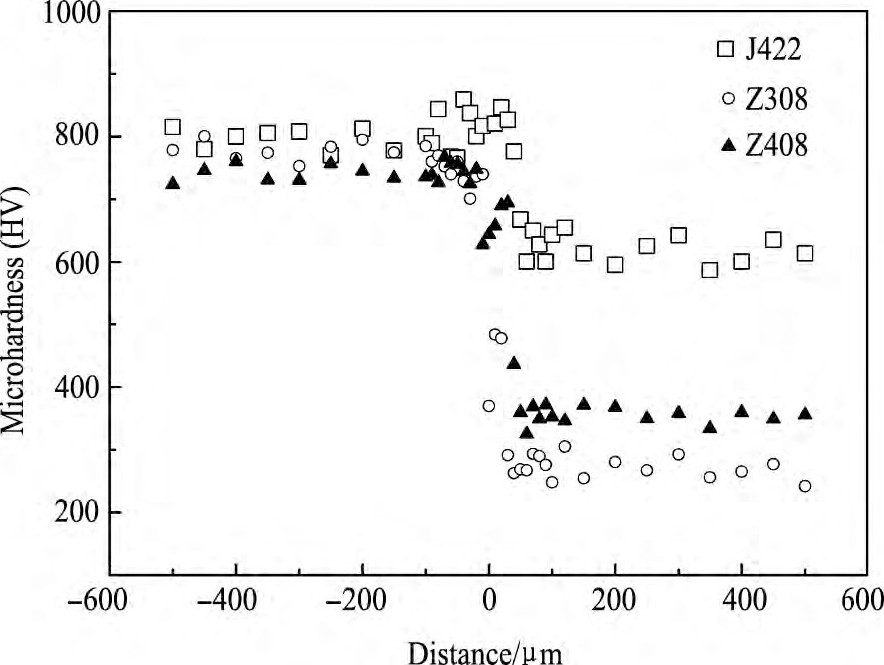网络首发时间: 2017-01-19 08:33
WC-Co-Ni硬质合金与45号钢焊条电弧焊研究
大连交通大学材料科学与工程学院
摘 要:
为研究硬质合金与碳钢焊条电弧焊连接的可行性, 选取低碳钢焊条J422、铸铁焊条Z308和Z408对WC-10Co-20Ni硬质合金与45号钢进行焊条电弧焊连接, 通过微观组织分析、X射线衍射 (XRD) 物相分析、硬度分布测试及弯曲强度测试等手段, 对比分析了3种焊条所焊接头的组织与性能, 研究结果表明:采用J422焊条焊接后, 焊缝组织以马氏体和共晶碳化物为主, 并含有η碳化物层, 接头结合强度弱, 不适于焊接硬质合金;Z308和Z408焊条可以抑制界面η碳化物层的生成, 但在焊缝中有大量夹渣, 影响接头性能;Z408焊条焊缝有少量的共晶碳化物产生, 但因熔敷金属的膨胀系数介于硬质合金与钢之间, 能有效缓解焊接应力, 较适合用于硬质合金的焊接。使用Z408焊条焊接时, 采取适当提高电流, 增加摆动频率等工艺措施, 可以减少夹渣的数量和分布状态, 促进成分和组织均匀化, 有利于提高接头性能, 弯曲强度可以达到WC-10Co-20Ni硬质合金母材强度的90%以上。
关键词:
中图分类号: TG444
作者简介:陈春焕 (1970-) , 男, 辽宁台安人, 博士, 教授, 研究方向:材料连接技术, 纳米材料制备与应用;电话:13942697208;E-mail:chchen@djtu.edu.cn;
收稿日期:2016-12-05
基金:辽宁省自然科学基金项目 (2014028023) 资助;
Shielded Metal Arc Welding of WC-Co-Ni Cemented Carbide and Steel 45
Chen Chunhuan Xia Shuang Shi Yanlong Zhao Xiujuan Ren Ruiming
School of Materials Science and Engineering, Dalian Jiaotong University
Abstract:
In order to investigate the feasibility of shielded metal arc welding ( SMAW) of cemented carbide and carbon steel, electrode J422, Z308 and Z408 were selected to weld the cemented carbide WC-10 Co-20 Ni and steel 45. The microstructures and properties of the as-welded joints were contrastively analyzed by microstructure observation, X-ray diffraction ( XRD) analysis, microhardness test and bending strength examination. The results showed that η carbide layer formed at the interface between the weld metal and cemented carbide, and microstructure of weld metal mainly consisted of martensite and eutectic phase, which resulted in the low bonding strength of the joint. Therefore, the electrode J422 was not fit for the welding of the cemented carbide and carbon steel. The formation of η carbide layer were prevented when the joints were welded by electrode Z308 and Z408, but there were too much slag inclusion in the weld metal which was harmful to the property of the joint. Compared to the electrode Z308, eutectic phase layer formed near the interface in the joint of Z408, however, due to the Invar effect of Fe-Ni alloy, the expansion coefficient of the weld metal of Z408 joint was between cemented and steel, and that was beneficial for the release of the welding stress. The bending strength of electrode Z408 joint was higher than that of electrode Z308, so electrode Z408 was more suitable for the welding of cemented carbide and steel. Enhancing the heat input properly and increasing the weaving frequency could reduce the amount of slag inclusion, change the distribution state of the slag and promote the homogenization of the composition and microstructure when electrode Z408 was used for the welding of cemented carbide WC-10 Co-20 Ni and steel 45. Those measurements were very favorable for the improvement of the property of the joint, so the bending strength of the joint could reach more than 90% of the WC-10 Co-20 Ni substrate.
Keyword:
cemented carbides; shielded metal arc welding; microstructure of welded joint;
Received: 2016-12-05
硬质合金有着很高的抗弯强度和硬度, 广泛应用于各种工业领域, 但因其存在价格昂贵、尺寸有限、形状简单、韧性差等缺陷, 所以将硬质合金与价格低廉、加工性能优异的钢连接具有很重要的意义[1,2]。但是硬质合金与钢的物理性能差异悬殊, 线膨胀系数二者之比近于1∶2, 从而给它们的焊接工作带来相当大的困难[3]。因线膨胀系数的差异所引起的残余应力, 导致焊后工件的破裂, 是一个长期困扰材料工作者而又难以根治的症结[4,5]。目前硬质合金和钢常用的焊接方法是钎焊和扩散焊。但钎焊有着结合强度低和不能在高温下使用等缺点, 而扩散焊存在生产设备要求高、硬质合金与钢界面易形成有害的η相、结合部位抗弯强度低等问题。现有的焊接方法都存在较难克服的弊端。
近些年来, 有研究者开始尝试电子束焊、激光焊、TIG (tungsten intert gas welding) 焊、MIG (metal inert-gas welding) 焊等新的熔化连接方法[6,7,8,9], 但目前关于商用焊条焊接硬质合金和钢的相关研究却极少, 特别是有关WC-Co-Ni系硬质合金与钢的连接更少, 而焊条电弧焊作为在生产和生活中应用最广泛的一种焊接连接方法, 设备简单并且应用方便, 因此WC-Co-Ni系硬质合金与钢焊条电弧焊的可行性具有重要的研究价值和应用前景[10]。本文首先制备WC-Co-Ni系硬质合金, 分别使用商用J422, Z308和Z408焊条与45号钢进行焊条电弧焊, 通过对焊接接头组织与力学性能的分析, 研究商用焊条用于硬质合金与45号钢电弧焊的可行性。
1实验
试验用母材为采用真空烧结工艺制备的WC-10Co-20Ni硬质合金以及热轧态的45号钢, 其主要化学成分见表1。将母材制成长宽为50×30mm, 厚度为5 mm的长方形板材, 沿长边 (50 mm) 开30℃坡口。填充材料分别选择直径均为3.2 mm的J422, Z308, Z408 3种商用焊条, 3种焊条熔敷金属化学成分如表2所示, 焊前将J422, Z308和Z408焊条在150℃下烘干2 h。
焊条电弧焊工艺参数为:采用对接接头, 开V形坡口, 用夹具固定, 间隙为1 mm, 焊前不预热, 焊后空冷。使用Fronius TPS 4000型多功能焊机, 直流电流120, 140 A。焊后用线切割沿着垂直于焊缝方向将接头切开, 制备成金相试样, 对试样进行研磨抛光, 使用Zeiss SUPRA55扫描电镜 (SEM) 对焊缝组织形貌和焊接缺陷进行观察分析, 用Oxford Xmax能谱仪进行微区成分测试。并利用Empyrean X射线衍射仪 (XRD) 分析了接头界面区的物相。
表1 母材的主要化学成分Table 1Chemical main composition of experimental ma-terials (%, mass fraction) 下载原图

表1 母材的主要化学成分Table 1Chemical main composition of experimental ma-terials (%, mass fraction)
表2 3种焊接材料熔敷金属化学成分Table 2Main compositions of three welding wires (%, mass fraction) 下载原图

表2 3种焊接材料熔敷金属化学成分Table 2Main compositions of three welding wires (%, mass fraction)
2结果
2.1熔合区显微组织与成分
3种焊条所焊接头的显微组织如图1所示, 鉴于硬质合金与钢电弧熔焊时最容易产生问题是在硬质合金一侧母材的熔合区, 因此本文着重对该位置进行分析研究。
图1 (a) 为120 A电流焊接的J422接头, 由图1可知焊缝/硬质合金界面处生成了约30~40μm厚的碳化物层, 由大块状和小块鱼骨状物相组成, 并且在焊缝侧靠近熔合区位置有一条细小裂纹。通过能谱分析发现大块状碳化物的铁钨原子数比Fe∶W接近1∶1, 小块鱼骨状碳化物的Fe∶W接近7∶5, 结合图2的XRD分析可知, 大块状碳化物为M6C型的η碳化物 (Fe3W3C) , 小块碳化物为共晶组织Fe3W3C-Fe4W2C。此外还检测到了马氏体, 表明硬质合金母材中的C, W, Co等元素过渡到熔池中, 增加了熔敷金属的淬硬倾向, 因此焊缝中产生了冷裂纹。
图1 (b, c) 是用120 A电流焊接的Z308和Z408的焊接接头界面区组织, 由图1可知, 在Z308接头的界面区未观察到新生成的碳化物, 但在焊缝里存在大量的夹渣, Z408焊缝中也观察到了大量夹渣。大量夹渣残留应与铸铁焊条的的工艺性不好有关, Z308焊条为纯镍焊芯, 熔池液态金属的粘度大, 熔渣的熔点高, 使得熔渣不容易上浮。Z408焊条为Ni-Fe焊芯, 其工艺性相比于Z308稍有改善, 因此焊缝中大块残留夹渣有所减少 (图1 (c) ) , 但在Z408接头的焊缝/硬质合金界面附近生成了一层共晶碳化物。
图1 接头界面区显微组织的SEM图像Fig.1 SEM images of microscopic structure of interface region
(a) J422; (b) Z308; (c) Z408; (d) Increasing thermal input Z408 (Z408M)
图1 (d) 为将焊接电流提高到140 A, 同时增加焊接时摆动频率的Z408焊条接头 (记做Z408M) 的界面区组织。由图1可知, 改进工艺后, 界面附近的共晶碳化物层也消失, 且焊缝中不再出现大块夹渣。同时成分检验的结果显示, 改进焊接工艺后, 界面附近的W含量由改进前的1.81%下降到1.13% (表3) , 可见提高热输入可以提高液态金属的流动性, 摆动的增加可以增强对液态金属的搅拌作用, 一方面使熔渣更容易上浮, 另一方面使成分均匀化, W元素不再主要集中在界面附近, 共晶碳化物层不再生成。
图2 接头界面区XRD分析Fig.2X-ray diffraction pattern of weld joint/WC-Co10-20Ni interface region
表3 几组焊缝界面区域成分Table 3 Composition weld interface area (%, mass fraction) 下载原图

表3 几组焊缝界面区域成分Table 3 Composition weld interface area (%, mass fraction)
2.2接头的弯曲强度与硬度分布
3种焊条所焊接头界面区的硬度分布如图3所示, 由图可知, J422焊缝的显微硬度平均约HV650左右, 远高于Z308和Z408的焊缝硬度, 同时J422接头的界面附近有多个HV 800以上硬度高点, 其硬度值高于硬质合金母材。Z408接头界面附近有几个HV 650~700的硬度高点, 焊缝内硬度平均为HV 350左右。Z308焊缝硬度相对较低, 平均260HV左右, 界面附近波动也较小。3种接头硬度分布的差别与焊后微观组织的不同有关, 如图2所示的XRD分析结果, J422焊条在界面处形成了一层η碳化物和共晶碳化物层, 在焊缝中形成了马氏体, 这3种相的硬度都较高。Z308和Z408的焊缝组织以γ (Fe, Ni) 固溶体和奥氏体为主, 因此硬度低, Z408接头中共晶碳化物层的存在使其界面附近硬度也存在个别高点。
图3 J422, Z408, Z308焊缝/硬质合金界面处的显微硬度分析Fig.3 Morphology hardness of rupture interface
各接头的弯曲强度及弯曲试样的断裂位置列于表4。由表4可知, J422接头的弯曲强度仅为0.408 GPa, 仅为硬质合金母材的1/3, 弯曲试样断于焊缝/硬质合金界面处, 其强度差主要是因为界面处形成了η碳化物层。Z308接头虽然在界面位置没有形成任何碳化物, 但其强度提高不多, 试样断于焊缝, 应与焊缝中大量存在的大块残留夹渣有关, Z408的焊缝也由于存在大量夹渣而使其强度仍然不够高, 但尽管Z408接头界面区生成了共晶碳化物层, 其强度还是高于Z308接头。经过对Z408的焊接工艺改进后, 接头的弯曲强度提高到硬质合金母材强度的90%以上 (表4中的Z408M) , 由于硬质合金母材受到焊接残余应力的叠加作用, 此时焊缝的抗弯曲能力高于焊后的硬质合金母材, 因而弯曲试样断于母材。
3讨论
从工艺性的角度看, 碳钢焊条J422的工艺性最好, 电弧稳定, 液态金属流动性好, 熔渣覆盖完整, 脱渣容易, 焊后成型好;Z308和Z408焊条工艺性相对较差, 熔池液态金属流动性不好, 熔渣粘度大, 覆盖不完整, 脱渣困难, 焊后成型不好。但J422焊条焊后在焊缝/硬质合金界面形成η相层, 弯曲强度仅为硬质合金母材的1/3, 不适于硬质合金的焊接。
当硬质合金与钢电弧熔焊时, η相通常在焊缝与硬质合金的界面处生成, 尺寸比WC颗粒粗大 (如图1所示) , 使接头性能显著降低。其形成的原因是[11,12,13,14]焊接时硬质合金侧的C含量高于焊缝, 部分WC失C分解, 同时钢侧母材的熔化使界面区Fe含量增加, 最终形成富Fe的W6C型η相。根据文献[11]所述, 当填充金属中Ni含量达到55% (质量分数) 左右, 并且不过多的填加强碳化物形成元素的情况下, 在界面附近形成的Ni-W-C合金体系多于Fe-W-C合金体系, Ni-W-C体系相对的平衡相区结构范围较宽, 不易形成碳化物, 而FeW-C体系容易生成游离碳相或M6C, M12C等缺C的第三相, 因此, Z308焊条的接头界面区几乎不生成碳化物, 而Z408焊条施焊时, 可以抑制η相的生成, 但较难避免共晶碳化物的生成。
表4 接头平均弯曲强度及断裂位置Table 4Bending strength of welded joints and rupture position (GPa) 下载原图

表4 接头平均弯曲强度及断裂位置Table 4Bending strength of welded joints and rupture position (GPa)
虽然Z408焊条的接头界面区仍有一层共晶碳化物, 其弯曲强度确高于Z308接头。由文献[15]可知, Fe-Ni合金具有因瓦效应, 可以根据Ni含量的不同估算其膨胀系数, 如图4所示, 通常硬质合金的膨胀系数为6×10-6~7×10-6℃-1, 碳钢的膨胀系数为12×10-6×10-6℃-1, 结合表3的成分检验结果, 由图4可以估算出, Z308焊条施焊的接头界面附近的熔覆金属膨胀系数约为12×10-6~15×10-6℃-1, 高于45号钢, 并远高于硬质合金, 因此焊后产生较大的残余应力;而Z408焊条熔敷金属的膨胀系数约为10×10-6~12×10-6℃-1, 介于硬质合金母材与45号钢之间, 过渡性的组合对这种缓解焊接应力十分有利, 使得Z408接头的强度高于Z308接头, 可见共晶碳化物层对接头弯曲强度的影响远小于膨胀系数差造成的残余应力, 因此Z408焊条更适于硬质合金与钢的焊接。
虽然使用铸铁焊条Z308和Z408施焊时避免了界面η碳化物的生成, 但Z308和Z408焊条在低热输入焊接时, 焊缝中残留夹渣较多, 其接头的弯曲强度与硬质合金母材相比下降较多, 弯曲时试样断裂位置位于焊缝处, 焊缝中的夹渣严重影响接头的性能。夹渣生成主要是因为熔渣熔点高、凝固快, 熔池液态金属的粘度高、流动性差[16]。为此, 本文对Z408焊条的焊接工艺进行了改进, 焊接时采取适当提高热输入同时增加摆动等工艺措施, 工艺改进后, 接头的弯曲强度达到了硬质合金母材的90%以上。热输入的增加, 可以提高熔池的温度, 使液态金属的粘度下降, 同时提高了电弧的吹力和对熔池的搅拌作用, 一方面使熔池中各种组分分布更均匀, 另一方面使熔渣更容易上浮, 再加上摆动的配合, 起到减少夹渣的数量和分布区域, 促进成分和组织均匀化的效果, 对接头性能的提高十分有利。
图4 Fe-Ni合金的线膨胀系数Fig.4 Coefficient of linear expansion (α) of Fe-Ni alloy[15]
4结论
1.J422焊条焊接WC-10Co-20Ni与45钢时, 焊缝与硬质合金界面处生成η碳化物层, 焊缝组织以马氏体和共晶碳化物为主, 接头结合强度弱, 不适于硬质合金焊接。
2.使用Z308和Z408焊条焊接时, 可以抑制界面η碳化物层的生成, 但两种铸铁焊条都容易在焊缝中残留夹渣, 对接头性能不利。
3.Z408焊条的接头虽然在界面附近生成了共晶碳化物层, 但由于Ni-Fe合金的因瓦效应, 其熔敷金属的膨胀系数介于硬质合金与钢之间, 对缓解焊接应力有利, 其接头的弯曲强度高于Z308接头, 更适于硬质合金与钢的焊接。
4.使用Z408焊条焊接时, 采取适当提高电流, 增加摆动频率等工艺措施, 可以减少夹渣的数量和分布状态, 促进成分和组织均匀化, 有利于提高接头性能, 弯曲强度可以达到WC-10Co-20Ni硬质合金母材强度的90%以上。
参考文献






